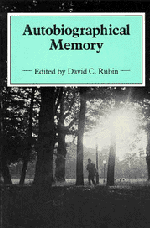Book contents
- Frontmatter
- Contents
- List of contributors
- Preface
- Part I Overview
- Part II Historical, theoretical, and methodological contexts for the study of autobiographical memory
- Part III The general organization of autobiographical memory
- 5 Nested structure in autobiographical memory
- 6 Schematization of autobiographical memory
- 7 Strategic memory search processes
- 8 Autobiographical memory: a developmental perspective
- Part IV The temporal organization of autobiographical memory
- Part V Temporal distributions of autobiographical memories
- Part VI Failures of autobiographical memory
- Author index
- Subject index
5 - Nested structure in autobiographical memory
Published online by Cambridge University Press: 01 March 2011
- Frontmatter
- Contents
- List of contributors
- Preface
- Part I Overview
- Part II Historical, theoretical, and methodological contexts for the study of autobiographical memory
- Part III The general organization of autobiographical memory
- 5 Nested structure in autobiographical memory
- 6 Schematization of autobiographical memory
- 7 Strategic memory search processes
- 8 Autobiographical memory: a developmental perspective
- Part IV The temporal organization of autobiographical memory
- Part V Temporal distributions of autobiographical memories
- Part VI Failures of autobiographical memory
- Author index
- Subject index
Summary
The study of any kind of memory should properly begin with a description of the material that is to be remembered. In the case of autobiographical memory that material consists of events that we have personally experienced – or, to put it another way, of our personal experiences of events. But what is an event? How are events experienced? This chapter is an attempt to open a discussion of those issues and of their implications for the study of memory. I shall focus on the fact that the events defined at one level of analysis may themselves be constituents of other, larger events. This “nested” structure appears not only in the events themselves but also in the way they are experienced and remembered. Because different levels of nesting are specified by different kinds of information, they can be perceived and remembered somewhat independently. Recalling an experienced event is a matter not of reviving a single record but of moving appropriately among nested levels of structure.
My own present activity offers a convenient example. What am I doing right now? Obviously, I am writing a chapter for David Rubin's book on autobiographical memory. Just as obviously, I am sitting at my word processor. More concretely, I am sitting on a chair facing a screen that displays what has already been written in small green-on-black letters. I am successively touching the individual keys of the word processor (and looking at them, too, because touch typing is beyond me) in order to produce that display.
- Type
- Chapter
- Information
- Autobiographical Memory , pp. 71 - 81Publisher: Cambridge University PressPrint publication year: 1986
- 99
- Cited by



